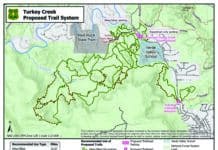As temperatures hit record highs this week, experts are warning people to take proper steps to not only stay healthy but to save a few dollars along the way.
In the Verde Valley, the thermometer peaked at nearly 110 degrees over the weekend, despite it still being June.
According to the Yavapai County Community Health Services, as much as Arizona residents seem to treat the heat as no big deal or at worst a mild annoyance, it’s actually a serious health risk.
Temperatures this high can put people at risk for heat-related injuries or medical complications, especially if they’re young, elderly, or have underlying medical conditions such as heart disease. If you are not able to keep your residence cool, you should consider leaving your home for the day and staying with a friend, or head to a building that is air-conditioned until temperatures drop in the evening.
“It does seem a little early but we just go by what the National Weather Service tells us,” David McAtee, of the YCCHS, said. “The heat is a concern of ours but so is the monsoon because it often results in power outages and then you have nothing.”
He said it’s important for people to take precautionary measures for themselves but also to check on any elderly family or neighbors to ensure they’re drinking enough and that the air conditioning is working properly. But the most important tip he said the department offers is simple yet many forget to do it.
“Drink lots of water, especially when you’re outdoors,” he said. “Don’t wait until you’re thirsty. If you wait until then, your body has already started to get dehydrated. Don’t over do it. This time of the year it may mean not being able to maintain your normal outdoor routines.”
McAtee said for those who have to work outdoors they need to drink plenty of fluids, take advantage of shade and take rest breaks. YCCHS urged people to know the signs of heat-related illnesses. They include:
- Thirsty: Being thirsty signals that you’re already starting to get dehydrated. As soon as you get thirsty, make it a point to drink some water and get out of the heat.
- Heat cramps: Cramping, pain and spasms in your abdominal muscles and legs signals that you losing too much water and salt. Drink water and get inside.
- Heat exhaustion: Signs you are entering dangerous territory include cool, moist, pale, flushed or red skin; heavy sweating; headache; nausea or vomiting; dizziness; and exhaustion. However, your body temperature will be near normal. With these symptoms, get inside right away and drink half a glass of cool water every 15 minutes until you improve.
- Heat stroke: During heat stroke, your temperature spikes and can damage your brain and internal organs. Other signs include hot, red and dry skin; changes in consciousness; rapid, weak pulse and rapid, shallow breathing. At this point, call 911 immediately.
Some ways to avoid heat illness include staying indoors, wearing lightweight clothes in light colors, taking regular breaks and, naturally, drinking a lot of water.
“This time of the year we always plan for the worst,” McAtee said. “I’m not a meteorologist, so I’m never sure what to expect but we always want to make sure we’re prepared for whatever may happen.”
Cutting Costs Representatives from APS, the state’s largest power provider, said there are ways to cut costs on your electric bill this time of the year.
According to APS spokeswoman Anna Stewart, there are many ways customers can stay cool and reduce costs as the temperatures continues to rise. One way of doing so is to turn your air conditioner thermostat up a degree. For every one degree AC thermostats are turned up, customers can save 2 to 3 percent monthly on their cooling costs.
Additional tips include:
- Use sunscreens or other shading devices on windows, especially those in direct sunlight. Forty to 50 percent of the heat coming into a house enters through windows.
- Use fans. While fans don’t actually cool the air, they can help reduce energy costs by creating a wind chill effect, which makes you feel cooler and more comfortable. Ceiling fans can allow thermostats to be set three to four degrees higher with minimal change in comfort.
- Repair any broken windows or gaps that allow cool air to escape. Also, keep doors and windows closed, and caulk around them to close the gaps.
- Whatever it is, turn it off when it’s not in use. Lights, computers, TVs and stereos all use less energy when turned off. It does not take more energy to turn them on and off frequently. If you will be away from home for a long time, unplug them.
- Do laundry, cooking and dishwashing during cooler times of the day. These tasks — especially using the oven — produce heat, which requires air conditioners to work harder to cool the home.
- Plant trees and other vegetation adjacent to windows, particularly on the west side of a home. This helps reduce heat by blocking the sun’s rays from entering your home.
- Change a light bulb. Save energy by changing out inefficient bulbs with more energy-efficient LEDs. LED bulbs use up to 90 percent less energy and can save an average of $80 in lighting costs over its lifetime. LEDs also produce less heat than traditional incandescent or CFL bulbs.


















